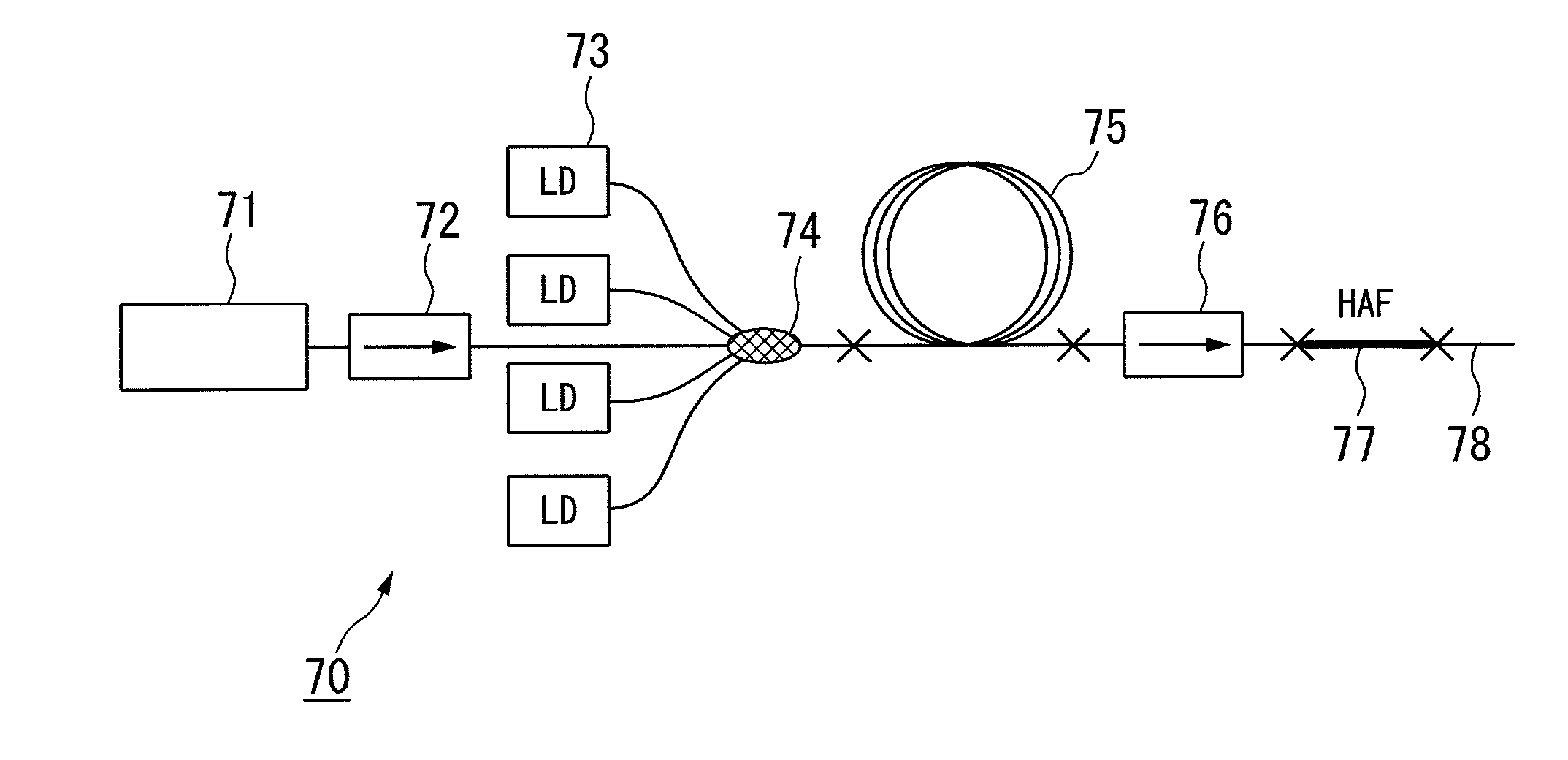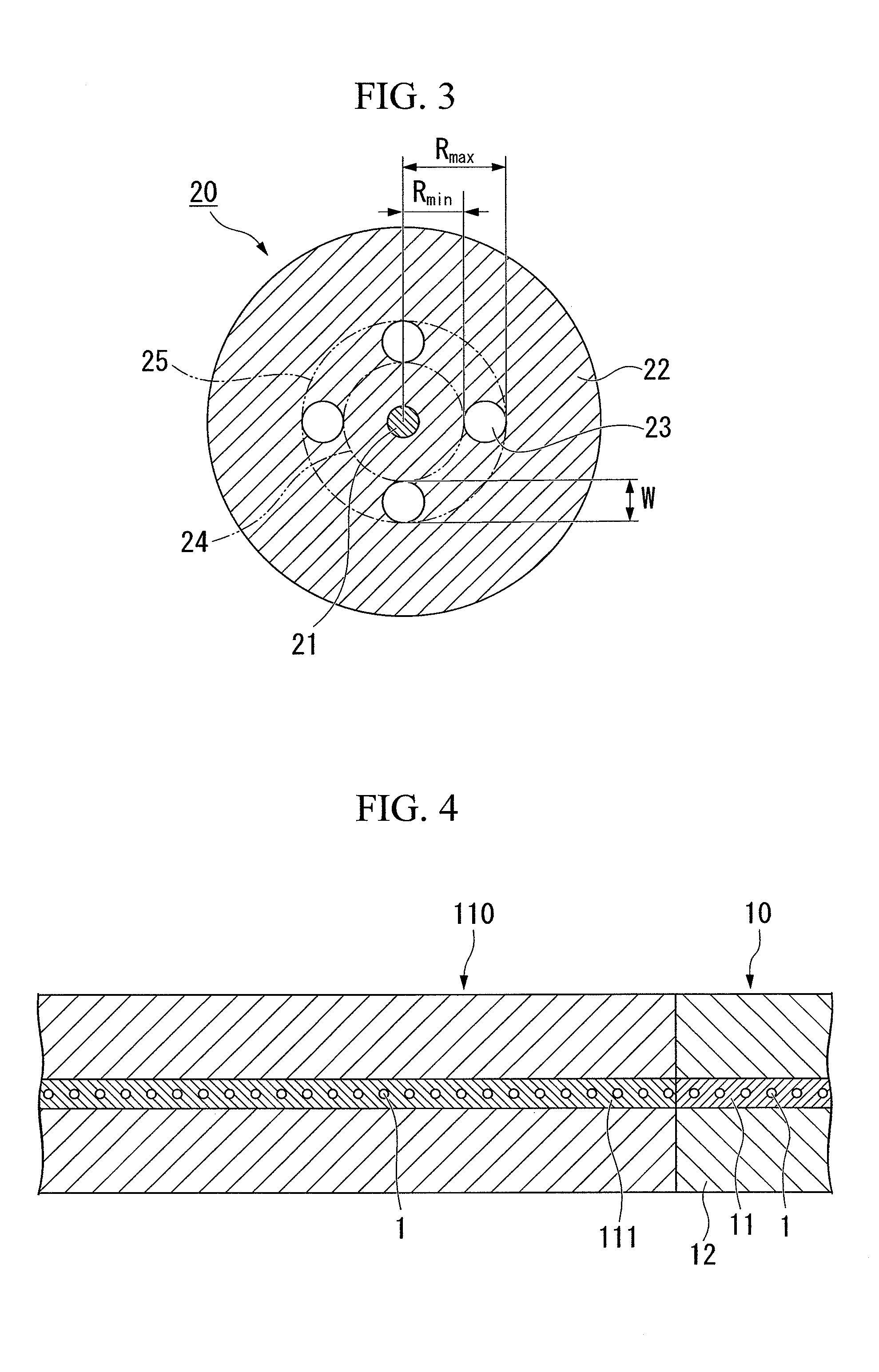Fiber fuse terminator
a fiber fuse terminator and fiber laser technology, applied in the direction of optics, instruments, optical elements, etc., can solve the problems of considerable loss at a portion, difficult to reduce splicing loss, and high cost, and achieve low cost, low splicing loss, and prevent damage to transmission equipment
- Summary
- Abstract
- Description
- Claims
- Application Information
AI Technical Summary
Benefits of technology
Problems solved by technology
Method used
Image
Examples
first embodiment
[0062]As shown in FIG. 3, a fiber fuse terminator according to a first embodiment of the present invention is constituted by an optical fiber (hereinafter, referred to as “hole-assisted optical fiber”) 20 which includes a core 21 having no holes and a cladding 22 with a plurality of holes 23 (4 holes in this embodiment) which are disposed so as to extend in a longitudinal direction, and in which the refractive index of the core 21 is higher than that of a portion of the cladding 22 excepting portions of the holes 23.
[0063]In the hole-assisted optical fiber 20 shown in FIG. 3, the holes 23 in one layer are provided in the cladding 22 so as to surround the core 21.
[0064]In this embodiment, it is possible to use the hole-assisted optical fiber 20 as a fiber fuse terminator by properly setting the ratio between the mode field diameter of the hole-assisted optical fiber 20 at a used wavelength and the distance from the center of the fiber 20 to the hole 23, the ratio between the mode fie...
second embodiment
[0108]A fiber fuse terminator according to a second embodiment of the present invention will be described in the following. The second embodiment is different from the first embodiment in that the holes are provided in a plurality of layers. The same components as those of the first embodiment are designated by the same reference numerals, and the description thereof will be omitted.
[0109]As shown in FIG. 11, the fiber fuse terminator according to this embodiment is constituted by an optical fiber (hereinafter, referred to as “hole-assisted optical fiber”) 20A which includes a core 21 having no holes and a cladding 22 with a plurality of holes 23 (60 holes in this embodiment) which are disposed so as to extend in a longitudinal direction, and in which the reflactive index of the core 21 is higher than that of a portion of the cladding 22 excepting portions of the holes 23.
[0110]In addition, in the hole-assisted optical fiber 20A shown in FIG. 11, the holes 23 are provided in a plura...
example 1
[0147]The HAF (Fiber A) having the cross section shown in FIG. 9 is used as the optical fiber 55 to be measured, and Experiments 1-1 and 1-2 were performed by changing the incident power.
[0148]The experiment numbers 1-1 and 1-2 in Table 1 show the parameters of Fiber A and the experiment conditions. As for Fiber A, the cladding diameter Dfiber is 125 μm, the number of the holes is 6, Rmin is 8.5 μm, W is 7.3 μm, Rmax is 15.8 μm, and the MFD at the wavelength of 1.55 μm is 10.2 μm. In addition, 2×Rmin / MFD is 1.67.
[0149]As for Fiber A, when the incident wavelength is 1.55 μm, and when the incident power is 9.8 W (experiment number 1-1) and when the incident power is 3.0 W (experiment number 1-2), the terminating performance of the fiber fuse was investigated. In both Experiments 1-1 and 1-2, the value of 2×Rmin / MFD is 1.67, which is in a range no less than 1.2 and no more than 2.1. The value of W / MFD is 0.72, which is no less than 0.3. In addition, since the value of W is 7.3 μm and t...
PUM
 Login to View More
Login to View More Abstract
Description
Claims
Application Information
 Login to View More
Login to View More - R&D
- Intellectual Property
- Life Sciences
- Materials
- Tech Scout
- Unparalleled Data Quality
- Higher Quality Content
- 60% Fewer Hallucinations
Browse by: Latest US Patents, China's latest patents, Technical Efficacy Thesaurus, Application Domain, Technology Topic, Popular Technical Reports.
© 2025 PatSnap. All rights reserved.Legal|Privacy policy|Modern Slavery Act Transparency Statement|Sitemap|About US| Contact US: help@patsnap.com



